Marking Time
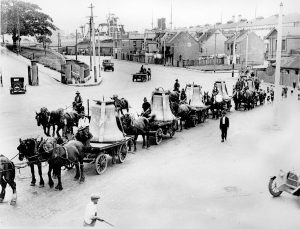
Bells being transported from the wharf to the University of Sydney ahead of installation of the carillon, March 1928. Courtesy University of Sydney Archives
This year’s History Week theme is Marking Time. How do you mark special occasions or a significant moment in time? For two local families, who each lost a son during World War I, marking time was literal when they contributed financially to the University of Sydney War Memorial Carillon which commemorates the 197 students, graduates and staff who died during the Great War. It was funded through private subscriptions and was dedicated on Anzac Day 1928 when visiting British carillonist, Bryan Barker, had the honour of ringing the first bell.
What exactly is a carillon? Samuel Garrett, writing for the University of Sydney’s publication Honi Soit notes that: ‘A carillon is a huge musical instrument, consisting of tuned bells played from a keyboard. Carillons are rare: only two others exist in Australia, in Bathurst and Canberra, and the University was to have the country’s first.’[1]
The carillon was first proposed in 1923 by the Evening Students’ Association as a suitable war memorial for the University and quickly gained widespread support. Bells have traditionally been used for many centuries – to summon people in times of danger and celebration. Fundraising activities included fetes and plays. It was a mammoth project as the bells needed to be cast in England by John Taylor and Sons and transported by ship to Sydney. From the wharf each bell would be taken by horse and cart to the University before being installed through the roof of the Quadrangle clocktower – which had to be reinforced and restructured for the purpose. There was enormous controversy during the next few years when another group insisted that the bells would require a separate tower or campanile.
With an expected cost of £15,000, each of the bells was to be funded by individuals or groups with names inscribed upon the bells in some instances. There were 62 bells representing 49 notes.[2] However, the 13 bells that duplicated the highest octave were not inscribed. The largest bell of all was dedicated to the AIF as a whole and was largely funded by public subscription. This, the heaviest bell, weighs 4250kg [3] and was inscribed simply ‘AIF’.
The Daily Telegraph of 29 April 1933 gives further details about the operation of the carillon and keyboards. See: https://trove.nla.gov.au/newspaper/article/246239276
You can view and listen to the carillon being played at: https://www.youtube.com/watch?v=Z5kuV7bQK0Y
A new clock was installed in the tower ahead of the carillon’s inauguration in 1928 with plans for the clock strike to be on the largest bell.
‘The clock will be equipped to play a melody as well as chimes on ten of the largest bells, including the largest. The mechanism will provide for the playing of melody or chimes just as required – at all hours or only at some hours or not at all. With the aid of the clock, also, it will be possible to arrange a concert of music by the automatic player whenever desired.’[4]
According to an article in 1930, ‘the music of the clock chimes is that of the University War Memorial Hymn, composed by Dr. S.H Nicholson, and is played by a separate mechanism.’[5]
An article from 1954 noted that the clock chimes had not operated for many years ‘to avoid disturbances during lectures.’[6]
Fundraising for the carillon was so successful during the 1920s that several of the bells were ‘given’ twice and inscribed with the names of individuals, groups or battalions. A program from the commemorations in 1928 list those for whom bells were donated.
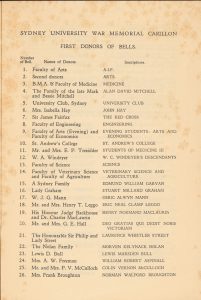
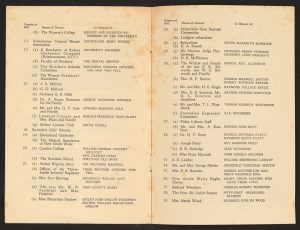
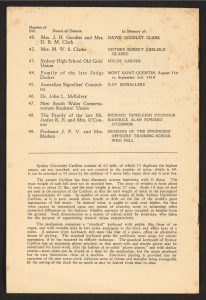
Pages from the program at the inauguration of the University of Sydney War Memorial Carillon, 25 April, 1928
Lieutenant Edward Callender Ross Nott of Bickley, Strathfield was travelling in Britain with his parents when war broke out. He quickly enlisted in London, serving firstly with the King Edward Light Horse and later with 9th Battalion King’s Own Yorkshire Light Infantry. He belonged to the extended David Jones family, many of whom lived in Strathfield. Nott received the Military Cross in 1915 for special gallantry at the Battle of Loos on the Western Front in September/October 1915 when he continued to lead and encourage his men although wounded himself. Still in London at the time, his mother concentrated her efforts on entertaining wounded and sick Australian soldiers at tea parties and other amusements.[7] Lieutenant Nott’s father, Arthur Ross Nott was a voluntary worker for the War Chest Fund.[8] Lieutenant Nott died of wounds, aged 22, in his father’s arms [9] on the Somme on 13 July 1916.[10] He was buried in the Abbeville Communal Cemetery in Picardie, France.
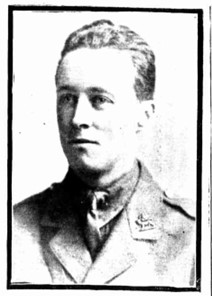
Lieutenant Edward Ross Nott. Sydney Mail 26 July 1916 p.23 https://trove.nla.gov.au/newspaper/article/160388299
Arthur and Alice Ross Nott donated £27 for a bell in memory of their son in the second round of donations for the carillon.
‘The new bells that have been given are all in the second series, and include one of £27 from Mr and Mrs A. Ross Nott, in memory of their son, Lieutenant Edward Ross Nott, M.C. who at the time of his death on the Somme from wounds, in July 1916, was an officer of the King’s Own Yorkshire Light Infantry.’[11]
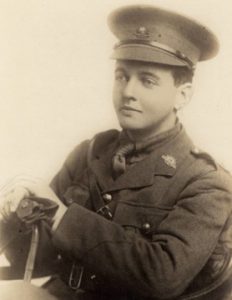
Lieutenant Lewis Marsden Bull. Courtesy Virtual War Memorial Australia
Lieutenant Lewis Marsden Bull was also aged 22 when he was killed by a shell at Herbecourt, France on 18 September 1918. Like Edward Ross Nott he was educated at Sydney Grammar School and was studying engineering at Sydney University when he enlisted for war during September 1915. An only child, he went on to serve with the 3rd, 55th and 1st Battalions, and had surgery for appendicitis in October 1917. Later that year he received his commission after being selected for the Officers Training Corps, Oxford. In January 1918 while patrolling behind enemy lines he was cut off from his regiment for three days. He was finally able to rejoin his regiment but suffered badly from frostbite. He was hospitalised in England and received a letter of congratulations from General Birdwood for ‘the wonderful fortitude and gallantry displayed.’ [12] He returned to the Western Front shortly before his death.
Bull’s parents were grief-stricken when they received the news that their only child had been killed while serving with the 1st Battalion. In March 1920, his father, also named Lewis Bull, wrote to authorities expressing a strong desire to have his remains brought to Australia if permissible, and offering to pay the expenses. In reply the War Graves Commission felt that ‘a higher ideal than that of private burial at home is embodied in these war cemeteries in foreign lands, where those who fought and fell together, officers and men, lie together in their last resting place, facing the line they gave their lives to maintain.’
Today the body of Lewis Bull remains in Roisel Communal Cemetery Extension, in Picardie, France. Locally, his parents erected a memorial to him in St Anne’s Anglican Church, Strathfield.
The inscription reads:
‘In loving memory of Lieutenant Lewis Marsden Bull 1st Battalion A.I.F. Killed in action Sept 18th 1918 at Herbecourt, France after three years service, aged 22 and 11 months. Only child of Lewis Daniel and Mary Amelia Bull.
“For ever with the Lord”.[13]
Sadly, Lewis Bull’s mother, Mary Amelia (nee Hordern) did not long outlive him, dying in December 1920. So it was his father, Lewis Daniel Bull who donated the cost of the carillon bell number 23 in his memory in 1924. Bull senior moved out of the Strathfield district after his wife’s death, married again in 1922 and died in 1926. A grazier, store owner and horse enthusiast, he also served as an alderman on Liverpool Council.[14] However, he did not live long enough to see the inauguration of the carillon which took place on 25 April 1928.
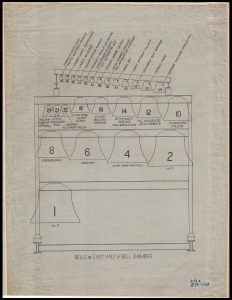
Bells in the east half of the chamber, including number 23, dedicated to Lewis Marsden Bull. Courtesy University of Sydney Archives.
The Chancellor, Sir William Cullen in his address ‘hoped that the music of the bells would be a consolation to those who loved and lost.’[15]
The Carillon has been played for many special occasions over the years including celebrating the birth of King Charles III in November 1948.[16]
By 1973 the bells needed maintenance and they were shipped back to John Taylor and Sons in the UK to be melted down and recast. They were not returned until 1977 when they were joined by an additional five bells giving the carillon a range of four and a half octaves.
Titus Grenyer, a new University Organist and Carillonist, was appointed in July 2024.[17] Today, the University of Sydney Carillon is played regularly for graduations and concerts during semester. Song requests are apparently welcome.
Both Lewis Marsden Bull and Edward Ross Nott are also commemorated on the Strathfield War Memorial honour boards at the Strathfield Council Chambers.
BY J.J. MacRitchie
Local Studies Advisor
References
[1] Garrett, Samuel ‘A History of the University Carillon’ IN Honi Soit 18 April 2021 https://honisoit.com/2021/04/a-history-of-the-university-carillon/[2] Sydney Morning Herald 12 March 1928 p.10 https://trove.nla.gov.au/newspaper/article/16448616
[3] University of Sydney https://www.sydney.edu.au/news-opinion/news/2018/04/24/9-facts-you-didnt-know-about-the-carillon.html
[4] Sydney Morning Herald 29 February 1928 p.14 https://trove.nla.gov.au/newspaper/article/16445708
[5] The Cumberland Argus and Fruitgrowers Advocate 31 July 1930 p.9 https://trove.nla.gov.au/newspaper/article/103859909
[6] Sydney Morning Herald 9 February 1954 p.11 https://trove.nla.gov.au/newspaper/article/18408810
[7]Sunday Times 17 December 1916 p.27 https://trove.nla.gov.au/newspaper/article/121345235
[8] Sydney Morning Herald 26 October 1915 p.10 https://trove.nla.gov.au/newspaper/article/15621121
[9] Sydney Morning Herald 18 July 1916 p.8 https://trove.nla.gov.au/newspaper/article/15690100?
[10] Sydney Morning Herald 21 October 1924 p.5 https://trove.nla.gov.au/newspaper/article/16165375
[11] Sydney Morning Herald 21 October 1924 p.5 https://trove.nla.gov.au/newspaper/article/16165375
[12] BULL LEWIS MARSDEN.pdf https://heurist-usyd.cloud.edu.au
[13] War Memorials Register https://www.warmemorialsregister.nsw.gov.au/content/bull-memorial-plaque
[14] Liverpool Council A4 EXHIBITION NOTES FRONT COVER_ NEW DISCOVERIES (nsw.gov.au)
[15] The Maitland Daily Mercury 26 April 1928 p.8 https://trove.nla.gov.au/newspaper/article/128198368
[16] Sydney Morning Herald 18 November 1948 p.2 https://trove.nla.gov.au/newspaper/article/18104623
[17] University of Sydney https://www.sydney.edu.au/news-opinion/news/2024/07/03/meet-the-new-university-organist-and-carillonist.html
